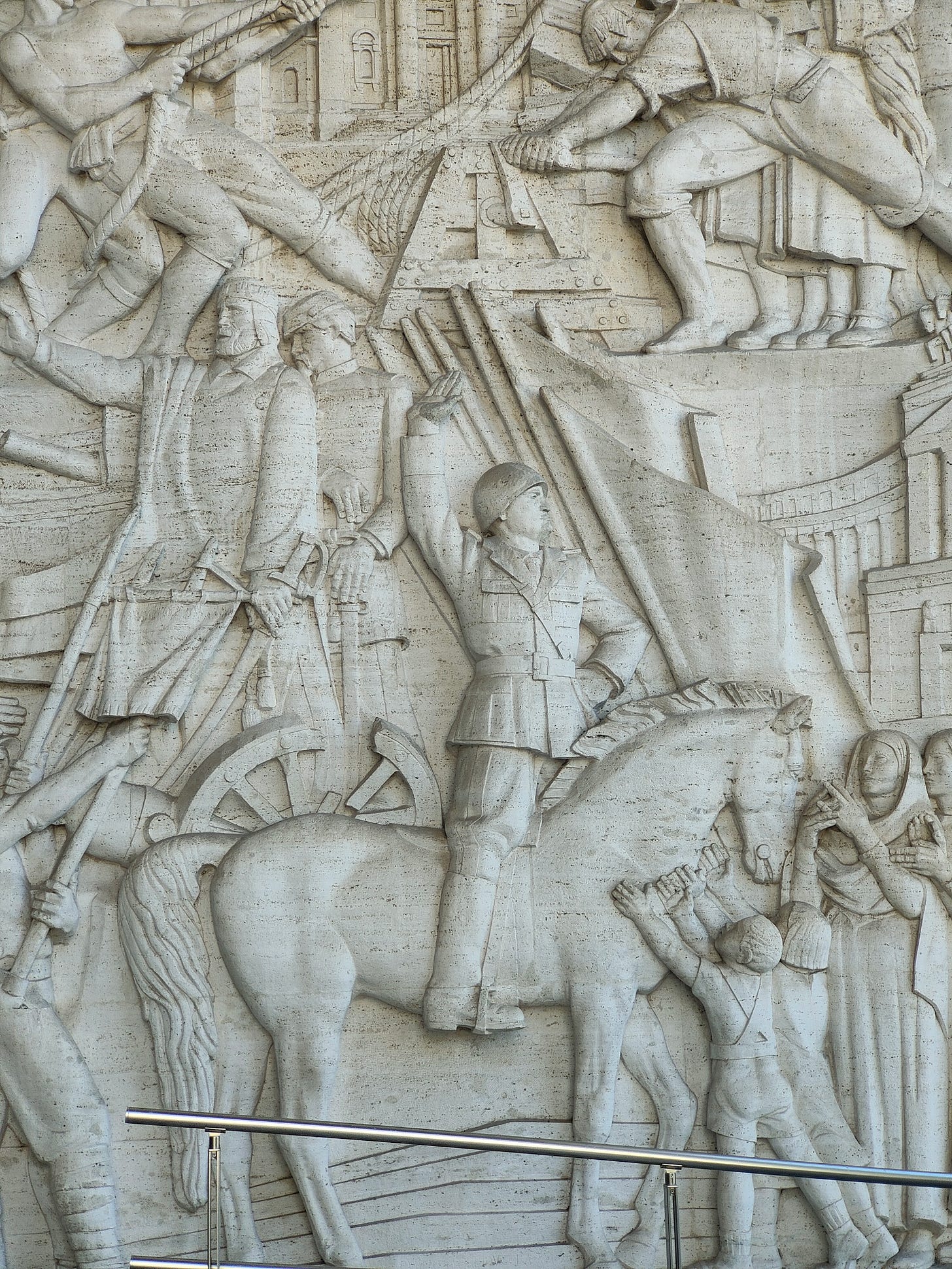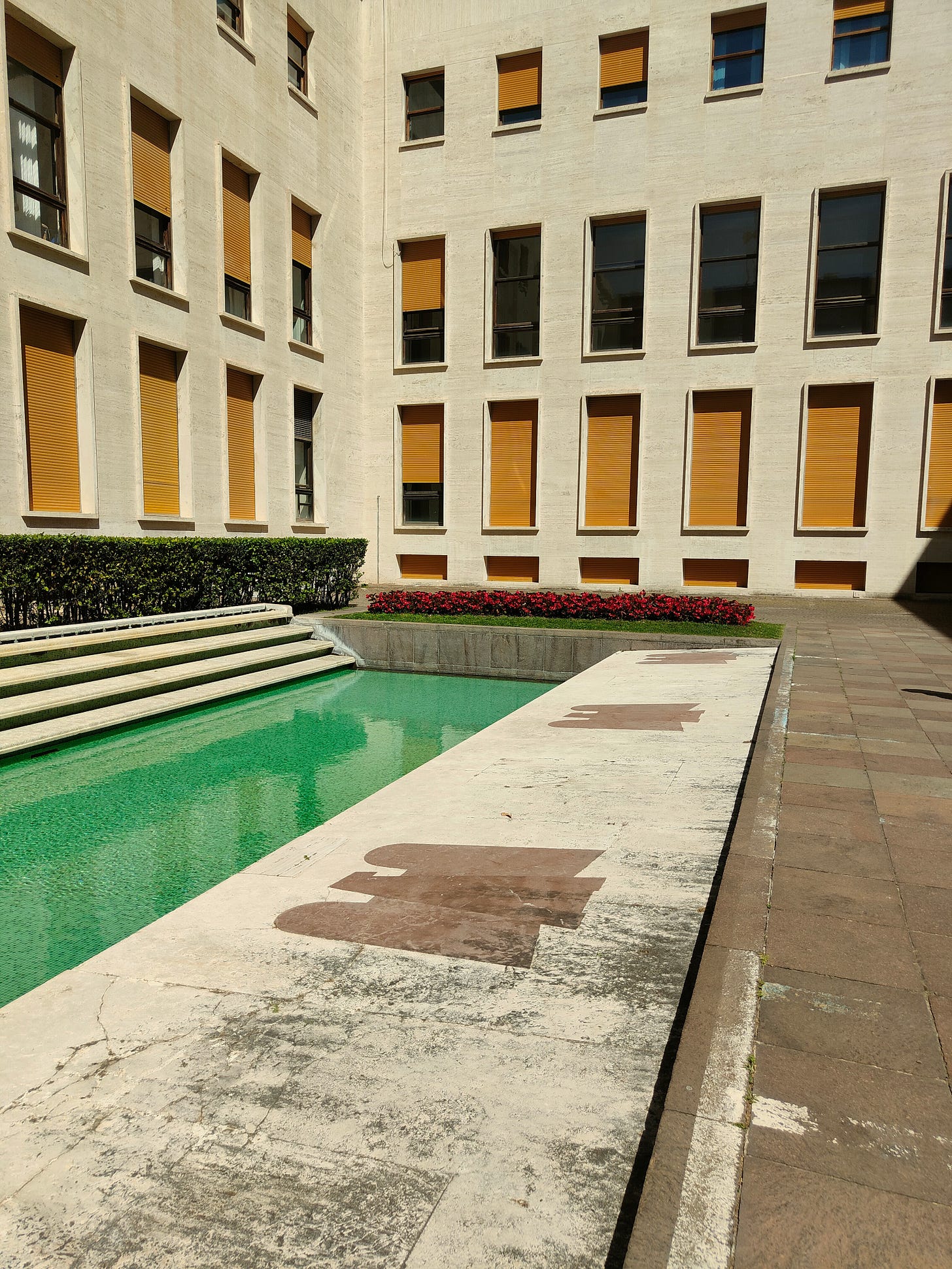Fascism vs. Despotism: what one building from 1939 built to celebrate Italy's totalitarian state can tell us about failed regimes.
Today's despotism resembles but does not follow the ideological objectives of historic Fascism. Present day despots, like those of the past, have other goals in mind.

What if this is not a bad dream and we actually just crash-landed into a working Fascist state? How would we know for sure? For some time now commentators, bloggers, and talking heads (myself included) have prepared us for the worst case political scenario, but at least up until now, we are experiencing something a bit more crude: in places like the United States the events unfolding appear to be inspired by an outdated edition of “Authoritarianism for Dummies.”
Yes, there is textbook corruption, the ominous public enemies lists, a “looming” constitutional crisis, masked armed thugs in the streets, sweeping mass deportations and random lockups, all potent signs of strong arm tactics being deployed without much hesitation. I’dd add: love for patriarchal rule, loyalty oaths to the great leader, and a war of revenge on liberal culture, its public institutions and universities.
But for me these are not necessarily symptoms of a Fascist state. What makes me so sure we are not yet entering Fascism proper? From my perch here in Rome, overlooking this vast Italian capital with its chaotic traffic and the ruins of past civilizations piled one on top another, I can confidently say we are not there yet. Instead we are going through another kind of authoritarian portal, one that shouldn’t be confused with the classic definitions of Fascism.

Instead, I believe the portal we are crossing through in this particular moment in time leads to a form of despotic authoritarianism. The Oxford American Dictionary defines a despot as: a ruler or other person who holds absolute power, typically one who exercises it in a cruel or oppressive way: acting illegally would give the despot an excuse to justify his criminality. Despotism sows no ideological seeds, since it builds on family enrichment and cronyism. I have come to see Fascism and Despotism as two different beasts, not that one comes off more favorably than the other. Just that at the end of the day, or lets say the end of the era, the relics of Fascism are far more ponderable and instructive than whatever vestiges Despotism usually leaves behind.
On a recent tour of one specific Fascist era building, the Ente Autonomo Esposizione Universale di Roma, known also as the Palazzo degli Uffici, located in the EUR district on the south side of Rome (visit courtesy of the Open House Rome program) all the contrasting elements on the question of what differentiates Fascism from Despotism falls neatly into place. The building’s origins, along with the entire EUR complex were conceived to become the site of the Worlds Fair, the segue to the New York Worlds Fair in 1939. The prospective date underwent a calendar adjustment: Mussolini’s government succeeded in pushing the international celebration ahead a year, to 1942, to coincide with the 20th anniversary of the founding of Fascism. The Italian Expo, E42, never was inaugurated: the construction site shut down when war broke out across Europe.
The Palazzo, designed by the architect Gaetano Minnucci (1896-1980), reads like an architectural guidebook on Regime styling. You are greeted at the formal entrance by a very tall marble bas-relief depicting a dense web of illustrated chronicles, a sort of greatest hits of Italian empires through history, providing many exaggerated depictions of conquests and epic events. Bottom center, in perfect view, is the unmistakable figure of the vainglorious Mussolini riding erect on horseback with his right arm raised in a fascist salute (a tempting pose for the likes of Elon Musk). Below, at the horse’s feet, women and children are shown offering tributes and blessings. Here in this one grandiose 3 dimensional storyboard is just about everything an aspiring fascist leader could dream of.

“True” fascism is what then? The noted historian Stanley Payne came up with a set of straightforward characteristics: a regulated economic structure, whether called national corporatist, national socialist, or national syndicalist… a self determined secular culture, the creation of symbols and political choreography, stressing romantic and mystical aspects, mass mobilization and militarization of political relationships… (Stanley Payne, Fascism: Comparison and Definition 1980). By these metrics, the current authoritarian policies coming, say out of the Trump administration, don’t follow most any of these principles.
Instead, I find closer resemblances to the introverted forms of personal dictatorships: the Spanish dictator Francisco Franco for one, or maybe more chillingly, François Duvalier, known to many simply as Papa Doc, the Haitian President for Life. Franco ruled with an iron fist from 1939 to 1975, backed by a heavily bloated military. The country’s ideology rested on a kind of nationalism that was fused to a strict Catholic practice. Franco became Head of State for life. And Franco’s Spain slid backwards for years until the dictator broke out of his isolationism. Most of Spain’s creative class fled into exile during Franco’s political reign.
Papa Doc ruled from 1957 to 1971, although he commanded over a much smaller nation, he seized total control over every inch of the island. Along with his personal militia, the Tonton Macoute, Papa Doc, and shortly after his death Baby Doc, ruled by terrorizing the country’s citizens, playing on their fears of black magic and superstition. Haiti has never really recovered since the Duvaliers’ dictatorship and the country continues to suffer through endless setbacks and economic hardships. While to some extent the Papa Doc regime promoted Black identity and Black culture, most of the country’s artists and writers fled to other parts of the world to avoid persecution.

The stark truth is that despotism doesn’t build a society so much as it drives it into the ground. I don’t want to make any gross generalizations, but its hard to ignore there are some quirky similarities between these despotic rulers from the past and whats going on now. Maybe the Tonton Macoute bears some vague resemblance to the insurrectionist Proud Boys or maybe the masked agents of ICE?
This also might sound like wild speculation, but there could well be a Baby Doc waiting in the wings among the current president’s family. Despots as far as I can tell are not beholden to any one ideology: whether its Swiss bank accounts or cryptocurrency, nepotism or family business, I see little to tie these kinds of despotic regimes to the ideologically hardened mass social experiments that dominated in the 1920s and 1930s.

The point is Fascism and Despotism are worlds apart. Looking at the Palazzo degli Uffici the building’s architecture offers a treasure trove of Fascist symbolism. The icons plastered across the buildings and around the courts and fountains celebrate events that are just oozing false hegemony.
Most of these symbolic contrivances were based on imaginary narratives retelling historic epics, colonial conquests along with heroic deeds, like the draining of the swamplands or the modernizing of Italy’s infrastructure. These were all fetishized tales to raise morale among Italy’s impoverished working classes, though they mostly served the regime’s myth-making machine to further their exploitation and coercion. Mussolini’s early propagandists invented loads of Fascist rituals, ceremonies and festivities to keep Italian society in its place. And there was no shortage of extremely talented literati, artists, architects, designers, photographers and filmmakers who willingly collaborated with the state to further their own careers.
I can’t recall many great contributions emerging under Catholic-centric Francoism nor for that matter under Papa Doc’s Lifetime Presidency. And from what is emerging out of bowels of Washington these days, it’s unlikely we will see much good come from the Trump cultural revolution either. With the possible exception of some really excellent farce.

There is no question Fascism committed vast injustices. No one should underestimate the extent of Mussolini’s tyrannical rule over the Italian nation, nor should anyone discount the real horror of Mussolini’s brutal colonial campaigns. And as Mussolini’s authoritarian’s grip on power weakened, he grew only more desperate, committing even greater acts of infamy. Just take a look at Mussolini’s second turn at governance during the short lived Republic of Salò.

Fascism was an epochal invention based on class hierarchy and corporatist ideology that was inevitably meant to fail. But if the protagonists in positions of power have long since disappeared, the architecture the regime produced still holds vivid reminders of Fascism’s broader legacy. Buildings like the Palazzo degli Uffici continue to exhibit signs of scars from previous defacements, though that which remains unscathed is even more intriguing, for what these preserved symbols could say for future generations.
I wonder about the fate of today’s despots and the unfortunate legacy they most likely will leave behind. I am sure it will not be pretty.




Bravo Peter for this vital essay offering insightful distinctions between fascism and despotism!